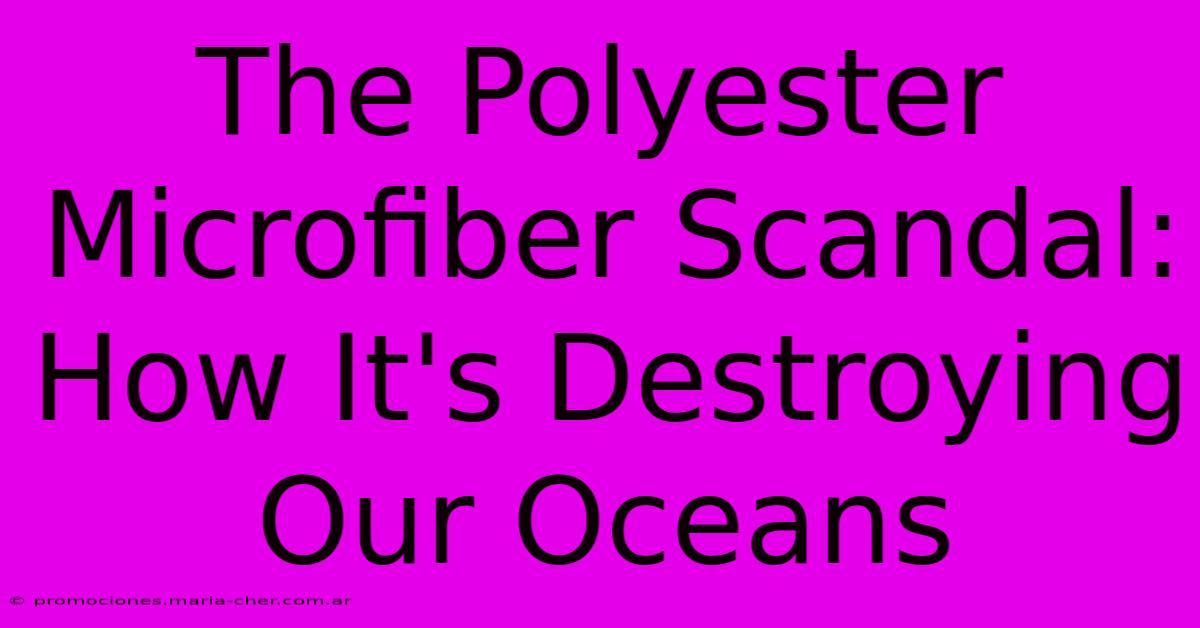The Polyester Microfiber Scandal: How It's Destroying Our Oceans

Table of Contents
The Polyester Microfiber Scandal: How It's Destroying Our Oceans
The seemingly innocuous polyester microfiber is silently wreaking havoc on our oceans. This ubiquitous fabric, found in everything from clothing to cleaning cloths, is shedding microscopic fibers at an alarming rate, polluting our marine ecosystems and harming marine life. This article delves into the devastating impact of polyester microfibers, exploring the scale of the problem, its consequences, and what we can do to mitigate this environmental crisis.
The Invisible Threat: Understanding Polyester Microfibers
Polyester, a synthetic polymer, is incredibly durable and inexpensive, making it a popular choice for clothing manufacturers. However, its durability is also its downfall. Each time we wash a garment made from polyester, tiny fibers break off and are released into our wastewater systems. These microscopic fibers, often invisible to the naked eye, are too small to be filtered out by most wastewater treatment plants. Consequently, they end up flowing directly into our rivers, lakes, and ultimately, the oceans.
The Scale of the Problem: A Sea of Microplastics
The sheer volume of polyester microfibers entering our oceans is staggering. Studies have shown that these fibers are now ubiquitous in marine environments worldwide. From the deepest ocean trenches to the most remote coastlines, microplastics, including polyester microfibers, are accumulating at alarming rates, creating vast swathes of plastic pollution. This pollution not only directly harms marine life but also disrupts the delicate balance of entire ecosystems.
The Devastating Consequences: Impact on Marine Life and Ecosystems
The effects of polyester microfiber pollution on marine life are far-reaching and devastating:
- Ingestion and Entanglement: Marine animals, from microscopic plankton to large whales, ingest these fibers, mistaking them for food. This can lead to internal injuries, blockages, and starvation. Furthermore, animals can become entangled in larger clumps of microfibers, restricting their movement and causing injury or death.
- Toxicity: Polyester microfibers can absorb and concentrate toxins from the surrounding water, further amplifying their harmful effects on marine life. These toxins can then bioaccumulate up the food chain, ultimately impacting human health as well.
- Habitat Destruction: The accumulation of microfibers on the seabed and in the water column can disrupt the habitats of many marine organisms, interfering with their breeding, feeding, and overall survival.
What We Can Do: Individual Actions and Systemic Change
Combating the polyester microfiber pollution crisis requires a multi-pronged approach involving both individual actions and systemic change:
Individual Steps to Reduce Your Impact:
- Choose Natural Fibers: Opt for clothing and textiles made from natural materials like cotton, linen, hemp, or wool whenever possible.
- Wash Less Frequently: Wash your clothes only when necessary to minimize fiber shedding.
- Use Laundry Filters: Install a washing machine filter specifically designed to capture microfibers before they enter the wastewater system. These filters are becoming increasingly available and affordable.
- Support Sustainable Brands: Support companies that prioritize sustainable manufacturing practices and use eco-friendly materials.
- Properly Dispose of Textiles: Recycle or donate unwanted clothing instead of throwing them away.
Systemic Solutions: Industry and Government Responsibility:
- Improved Wastewater Treatment: Invest in upgrading wastewater treatment plants to effectively filter out microfibers.
- Regulation and Legislation: Governments need to implement regulations and legislation to hold manufacturers accountable and reduce the production and use of polyester and other synthetic fibers.
- Innovation and Research: Invest in research and development of biodegradable and sustainable alternatives to polyester.
- Consumer Education: Raise public awareness about the problem of polyester microfiber pollution and promote responsible consumption habits.
The polyester microfiber scandal is a stark reminder of the unintended consequences of our consumption habits. Addressing this issue requires a collective effort from individuals, industries, and governments. By taking action now, we can help protect our oceans and the marine life they support for generations to come. The future of our oceans depends on it.

Thank you for visiting our website wich cover about The Polyester Microfiber Scandal: How It's Destroying Our Oceans. We hope the information provided has been useful to you. Feel free to contact us if you have any questions or need further assistance. See you next time and dont miss to bookmark.
Featured Posts
-
Appendectomy Without Insurance A Financial Nightmare Or Just A Headache
Feb 09, 2025
-
Unlock The Secrets How Fast Can I Heal After Toe Amputation
Feb 09, 2025
-
Unveiling The Hidden Gems The Most Underrated Nba Legends That Deserve Recognition
Feb 09, 2025
-
The Cheetahs Of Baseball Ranking The Mlbs Fastest Runners Ever
Feb 09, 2025
-
Rosh Hashanah Card Inspiration A Library Of Ideas For Unforgettable Wishes
Feb 09, 2025
